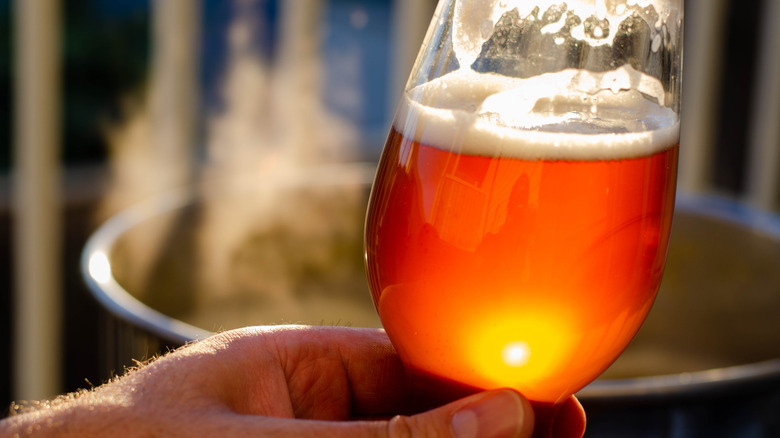How Sour Beers Get Their Distinct Bite
Even in the lawless frontier of modern beer brewing, where it seems like a new style is being debuted every year, sour beer stands out. Beer runs a massive gamut of tastes, from crisp and light to dark and toasted, all based around a very simple list of four ingredients: water, hops, a grain, usually barley, and yeast (via MasterClass). The magic, and challenge, of brewing is that this basic list can be manipulated in a million different ways to emphasize different flavors and characteristics of these signature elements, producing two drinks as different as an IPA and a porter.
Some of the most unpredictable and complex of these styles are the so-called sour beers, a nebulous term that includes a range of regional varieties like the German gose or Belgian lambic, mostly united by the acidic kick that makes them stand out from almost every other beer (via Beer and Brewing). In the endlessly shifting craft beer market, sour beers have seen a surge in popularity over the last five years with growth rates above 40% in both 2018 and 2019, according to Forbes. But how do sour beers get that unique taste that has driven this growing interest from drinkers?
Wild yeast and unique bacteria add complexity
Bacteria really gets a raw deal in the world of food and drink, but we wouldn't have a lot of fermented products without the hard work it puts in. According to Allagash, the bacteria that lend their signatures to sour beer are Lactobacillus and Pediococcus, which feast on sugars the same way yeast does and produce lactic acid. These bacteria can be introduced at different times in the brewing process, either directly, in reused barrels, or by introducing previously brewed sour beer into a new batch. However it happens, the end result is differing degrees of that refreshing bite that makes sour beers so drinkable.
The other standout addition to sour beer is a strain of wild yeast, Brettanomyces, similar to what you would find in sourdough (via Craft Beer). In contrast to other yeasts that produce a predictable final product, Brettanomyces is a wild card that can produce a multitude of flavors at different times in the brewing process. It can also turn alcohol into acetic acid, which has a vinegary quality that adds to sour beer's funky complexity and tartness. The downside to this wild blossoming of flavors is risk: This variety of yeast spreads easily and can infect other batches of beer, ruining them. So if you're someone who loves sour beers in all their unique glory, raise your glass to the brewers who take these chances to bring them to you.

